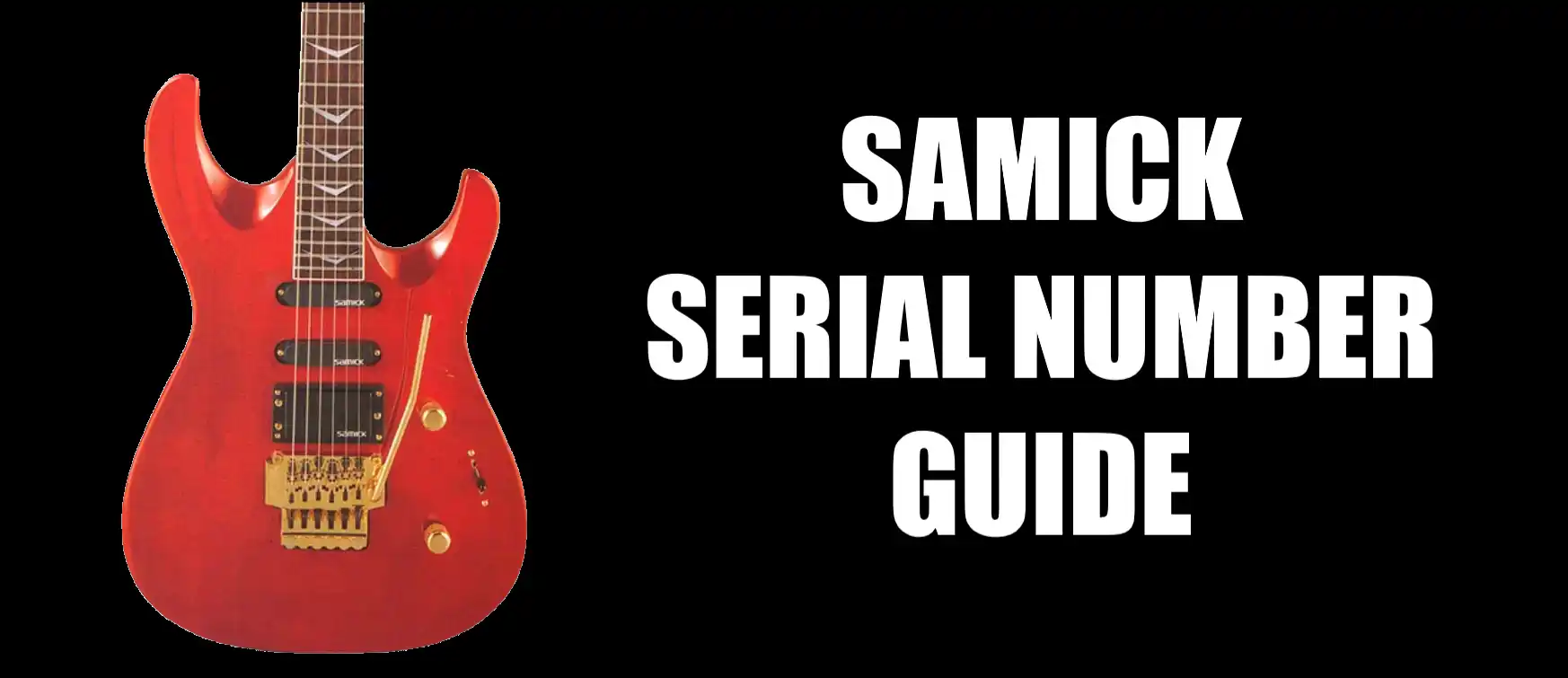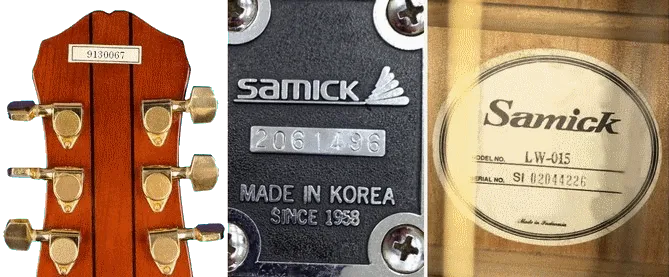
Samick started assigning serial numbers to their guitar models around 1987, while Hondo guitars began featuring serial numbers in 1984.
The Samick serial number guide provided below can help you look up the production year of your guitar.
Table of Contents
Where to Find Samick Serial Number?
The serial number can be found on the back of the headstock or the neck plate, and on (semi) acoustic guitars, it may be located on the bottom inside of the body, either stamped or displayed as a sticker.

Samick Serial Number Dating Guide
A Samick guitar can be dated by its serial number, which typically consists of a letter and several digits.
Here is a general guide to dating Samick guitars based on their serial numbers:
1. For Samick guitars made between 1979 and 1986, the serial number starts with a letter followed by 6 digits.
The letter indicates the month of production, with A = January, B = February, and so on.
The first two digits of the serial number indicate the year of production.
For example: A guitar with the serial number D834562 would have been made in April 1983.
2. For Samick guitars made between 1987 and 1993, the serial number starts with 2 letters followed by 6 digits.
The first letter indicates the year of production, with A = 1987, B = 1988, and so on.
The second letter indicates the month of production, using the same code as before.
For example: A guitar with the serial number BA834562 would have been made in January 1988.
3. For Samick guitars made after 1993, the serial number starts with 2 digits followed by 2 letters and 4 digits.
The first two digits indicate the year of production, while the letters and remaining digits indicate the month and production number.
For example, a guitar with the serial number 93SA1234 would have been made in 1993, in October (S), and was the 1,234th guitar produced that month.
It’s worth noting that these serial number systems are not always consistent, and there may be some overlap between years or variation in production numbers. Additionally, some Samick guitars were made for other brands or companies, and their serial number systems may differ.
If you’re unsure about the date of your Samick guitar, it’s best to consult a professional or contact Samick customer service for assistance.
Samick History
Samick Musical Instruments Co., a Korean company founded in September 1958, is one of the largest producers of musical instruments in the world.
The company began producing acoustic guitars in 1965 and electric guitars in 1972.
In 1976, Samick released good-quality copies of the Fender Stratocaster and the Gibson Les Paul under the Hondo II brand.
Samick manufactures guitars under its own brand name, but mainly under OEM licenses for major brands like Fender, Squier, Gibson, Epiphone, Gretsch, Ibanez, Jackson, and others.
Initially, Samick’s founder, Lee Hyo-Ik, was the Korean importer of Baldwin Pianos. Around 1960, he started building his own pianos, first from imported parts and later from homemade ones. The pianos were sold in his shop next to the factory.
Success came quickly, and in 1964, Samick exported pianos to the USA. A year later, guitars were also built for the Korean market and for export, as there was a high demand for cheap Asian guitars.
In the early 1970s, Samick grew into a company with more than 3,000 employees.
On January 20, 1978, a Samick branch was opened in Los Angeles, and on December 11, 1980, a branch office in Dusseldorf, Germany, was established to introduce the brand to the European market.
On June 9, 1989, another branch was opened in Harbin, China, and on March 2, 1990, a branch office in Tokyo, Japan.
In March 1992, a factory was opened in Cileungsi near Bogor, Indonesia (PT Samick Indonesia), where the vast majority of instruments are now built.
Sales of Samick instruments in the USA were so successful that on July 1, 1987, an American subsidiary, the Samick Music Corporation (SMC), was opened. The company expanded its range for the international market considerably by developing a line-up based on American examples such as Gibson and Fender.
In 2006, Samick moved its complete production to Bogor, Indonesia, and discontinued production in Incheon due to increasing labor costs in South Korea.
Hondo Guitars.
Samick entered into a joint venture with the American company International Music Corporation (IMC) in Fort Worth, Texas, in 1969, and the Hondo Guitar Company was born.
Under the brand name Hondo, they started producing cheap guitars with modern manufacturing techniques but with American quality standards. Initially, they produced only acoustic models. They started producing electric models in 1972 and, from 1976, mandolins and banjos.
At the end of 1976, models were released under the name Hondo II, which were based on the Fender Stratocaster and the Gibson Les Paul.
From 1978, these were equipped with DiMarzio pickups.
In 1979, more than 790,000 Hondo guitars were sold worldwide.
Until 1989, Hondo guitars were mainly produced at the Samick factory in Korea.
In 1995, the Hondo Guitar Company was sold to MBT International, Musicorp. With a renewed production line, the brand name Hondo was replaced by the name J.B. Player, of which Musicorp also owns the proprietary rights.
SPG.
In 2003, a group of Samick employees established SPG (Sound Professional Guitar Co., Ltd company), fearing that Korean production would disappear. After production ceased in Korea, SPG bought Samick’s factory, maintaining the quality of the products, and many brands continued to outsource their assignments to SPG.
Greg Bennett Guitars.
Greg Bennett, a former guitar builder at Gibson, was approached by Samick to design a new line of instruments. The new line includes acoustic and archtop guitars, bass, mandolin, ukulele, and banjo in addition to electric models.
The instruments were released around 2011 under the “Greg Bennett Guitars” label. These electric models feature Seymour Duncan-designed pickups, Grover tuners, and Wilkinson bridges, making them high-quality instruments for musicians at any level.
Some electric models designed by Greg Bennett: Avion, Ultramatic, Torino, Formula, Lasalle, G series.
Samick guitars are just incredibly cool. Sure, they’re not expensive or super flashy, but they’re always reliable! Every Samick guitar I’ve held, whether vintage or new, has been of a quality that surpasses even some of the more famous brands in the same price range. These guitars are definitely worth considering if you need a solid instrument rather than just a trendy brand. I’ve always been impressed, and I’ve owned a few myself. They’re a significant part of guitar-making history, and they’re always worth your attention!